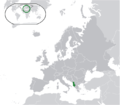Click here to register!
Albania Energy Situation
Capital:
Tirana
Region:
Coordinates:
41.0000° N, 20.0000° E
Total Area (km²): It includes a country's total area, including areas under inland bodies of water and some coastal waterways.
28,750
Population: It is based on the de facto definition of population, which counts all residents regardless of legal status or citizenship--except for refugees not permanently settled in the country of asylum, who are generally considered part of the population of their country of origin.
2,777,689 (2022)
Rural Population (% of total population): It refers to people living in rural areas as defined by national statistical offices. It is calculated as the difference between total population and urban population.
36 (2022)
GDP (current US$): It is the sum of gross value added by all resident producers in the economy plus any product taxes and minus any subsidies not included in the value of the products. It is calculated without making deductions for depreciation of fabricated assets or for depletion and degradation of natural resources.
18,916,378,861 (2022)
GDP Per Capita (current US$): It is gross domestic product divided by midyear population
6,810.11 (2022)
Access to Electricity (% of population): It is the percentage of population with access to electricity.
100.00 (2021)
Energy Imports Net (% of energy use): It is estimated as energy use less production, both measured in oil equivalents. A negative value indicates that the country is a net exporter. Energy use refers to use of primary energy before transformation to other end-use fuels, which is equal to indigenous production plus imports and stock changes, minus exports and fuels supplied to ships and aircraft engaged in international transport.
13.80 (2014)
Fossil Fuel Energy Consumption (% of total): It comprises coal, oil, petroleum, and natural gas products.
61.42 (2014)
Introduction
Albania is a country in Southeastern Europe, bordered by Montenegro to the northwest, Kosovo to the northeast, Macedonia to the east, and Greece to the south and southeast.[1]
About 60% of Albanian energy demand is met through the fossil fuels. In terms of electricity generation, about 90% of the electricity is generated from hydropower. With the ongoing climate change, energy security could become a critical concern in Albania.[2]
Energy Situation
Renewable Energy
Fossil Fuel
Key Problems of the Energy Sector
Policy Framework, Laws and Regulations
A. Legal Instruments
Now, as far as the future is concerned, new opportunities unfold from the transformations. Referring to the new strategy by 2030, it is planned to continue on the integration of two main pillars: which regard the completing the reforms of market liberalization in the context of regional integration, and the promotion of sustainable development, within five analytical scenarios, built to pave the way to the pursuit of the priorities that will be defined by concrete action plans prepared and presented by the interested private players.
On above, regarding the sustainability component, the last NREAP 2019-2020, confirm that renewable investments could continue to rely on incentives, fiscal and non-tax facilitations. In terms of target setting for renewable energy, it foresees a 38% of Albania’s gross final energy consumption by 2020. Further, according to the National Energy Strategy 2030, renewable energy share aims to raise at least 42% by 2030.
B. Enabling Frameworks
Until recently, Albania had a limited supportive regulatory framework for the deployment of renewable energy sources, other than hydropower since 2007. A change of game came with approving of the new RES law of the second generation in 2017. A legal framework that enables the feed-in tariff available for new and existing small hydropower plants with a capacity of up to 15 MW, but also the solar PV plants up to 2 MW and wind power plants of up to 3 MW.
A new framework that was followed by first with the agreement between the MIE and the European Bank for Reconstruction and Development (Ebrd) on May 6, 2017, and then the one of the Ebrd - Energy Community Secretariat (EnC) on June 9, 2017. The agreements that see the engagement to accompany the process bringing expertise, and overseeing the approval of competitions with transparency and full integrity to attract the interest of big international actors for the developing of 700 MW capacity in the PV worth half a billion euros by 2020.
C. A feed-in tariff support system
The above was finalised in Albania with the approve the new NREAP 2019-2020 that rises the PV capacity planned form 120 MW to 490 MW, the wind from 70 MW to 150 MW, and the biomass from 8 MW to 41 MW. Further, on, the mentioned strategy provides a solid framework that will also serve as a basis for the development of an integrated National Energy and Climate Plan (NECP) as the other union members within the end of 2020, which will serve as the base for the NREAP 2030.
D. Premium tariff/Contract for Difference
The larger renewable energy power plants are eligible for a Premium Tariff by a Contract for Difference (CfD). The tariff is determined in a competitive bidding auction process. The CfD, according to the RES Law 2017, is foreseen to have a duration of 15 years.
- ↑ http://en.openei.org/wiki/Albania
- ↑ Albania Energy Sector. Retrieved from :http://bit.ly/1xE4dar
Institutional Set up in the Energy Sector
Further Information
Reference
- ↑ https://adviser.albaniaenergy.org/en/2020/08/10/advlorencgordani/albania-toward-large-and-sustainable-developments-by-lorenc-gordani/
- ↑ Cite error: Invalid
<ref>tag; no text was provided for refs namedhttps://adviser.albaniaenergy.org/en/2020/08/10/advlorencgordani/albania-toward-large-and-sustainable-developments-by-lorenc-gordani/





















